DISCLAIMER: THIS PAGE DOES NOT PROVIDE MEDICAL ADVICE.
This page is intended for informational purposes only. No material on this page is intended to be a substitute for professional medical advice, diagnosis, or treatment. Always seek the advice of your physician or other qualified healthcare provider before changing your dietary or cooking habits.
In Short
Yes, Enameled cast iron is generally considered safe to cook with if it is labeled lead-safe by California Proposition 65 standards. Products from “knock-off” brands are less likely to undergo strict safety testing, especially those imported from countries with less consistent quality control.
Make sure to read this entire article because we’ll discuss what can make enameled cast iron cookware unsafe and how to know if yours is safe.
Enameled cast iron is an incredibly versatile cookware material that is nonreactive and will last a lifetime if you take care of it.
But, if you’re researching this cookware, you have probably uncovered concerns about lead and cadmium found in enameled cast iron pans. I know this is a scary prospect, but don’t lose hope; I’ll summarize the current research on this topic and introduce you to reliable brands of enameled cast iron cookware that prioritize safety.
I have combed through practically all the available information on this topic so we can look at it in detail and find out, once and for all, whether this material is all it’s cracked up to be – and if it’s safe to use.
In this article, I will dive into the following:
I’m sure we are all familiar with those black, solid cast iron pans hiding at the back of our parents’ cookware cupboards. While it is very durable, raw cast iron will react with acidic foods and will leach iron into your food. This can discolor your food and leave behind a metallic taste. That’s where enamel coatings come in to save the day.
From my research, the safest enameled cast iron can be found in reputable brands like Le Creuset, Staub, and Lodge. These may not be 100% toxin-free – but if you dig into the research, literally no cookware is truly 100% guaranteed toxin-free. The best you can get is “likely to be safe.”
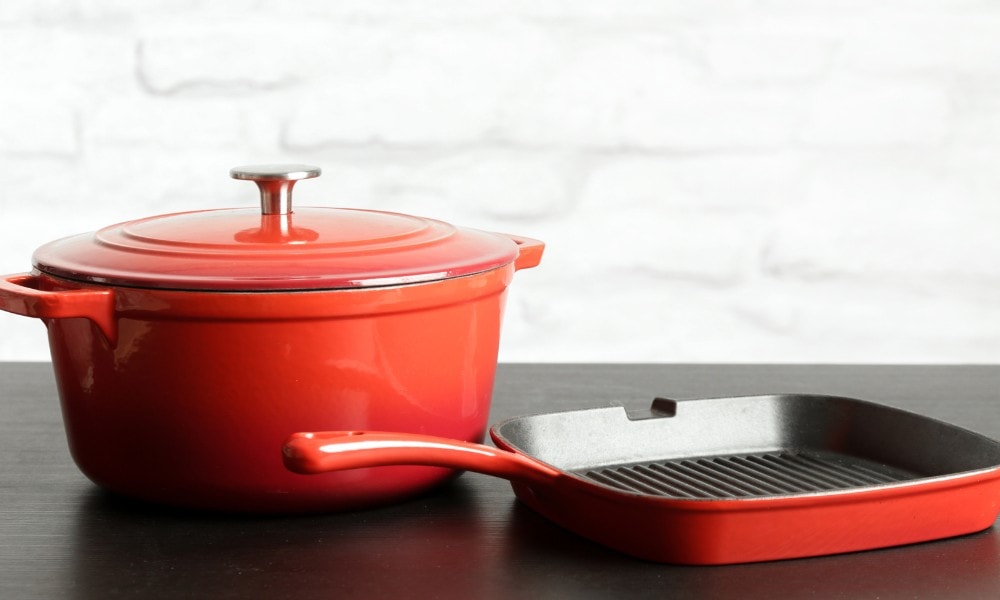
What Exactly is Enameled Cast Iron?
Enameled cast iron is made of natural cast iron coated in at least two layers of enamel glaze. The glaze forms a glass-like porcelain surface that will not leach iron. This glaze consists of porcelain particles that are powder coated across the surface of the metal using an electrostatic or a corona gun. This is repeated before slowly firing at high temperatures to adhere the glaze to the metal.
The enamel is nonreactive and resistant to thermal shock. It also protects the metal from corrosion.
Heavy Metals in Enamelware
The primary health concern involved in enameled cast iron cookware is the presence of heavy metals like lead and cadmium. Lead was originally used in the glazing process to give that smooth, glass-like finish. This traditional glazing method has been left behind in favor of safer techniques in modern cookware.
The FDA regulations and California Proposition 65 enforce stringent rules and tests to control cookware’s acceptable levels of lead and cadmium. If the levels are exceeded, then the product must be clearly labeled.
Cookware that falls within the Proposition 65 guidelines will be labeled ‘lead-safe.’ If you want cookware with no trace lead levels, you need to look for a ‘lead-free’ label – and ask for third-party testing certification.
Lead in Vintage Enameled Cast Iron or Ceramic Cookware
If you like to thrift your cookware, you must be very careful about testing your cookware before using it. In the 1970s, high levels of cadmium were found in the pigments used to color the inside of enamelware. In those days, the regulations about heavy metals were not as strict as they are today, so they have a higher risk of containing these harmful metals in unsafe quantities.
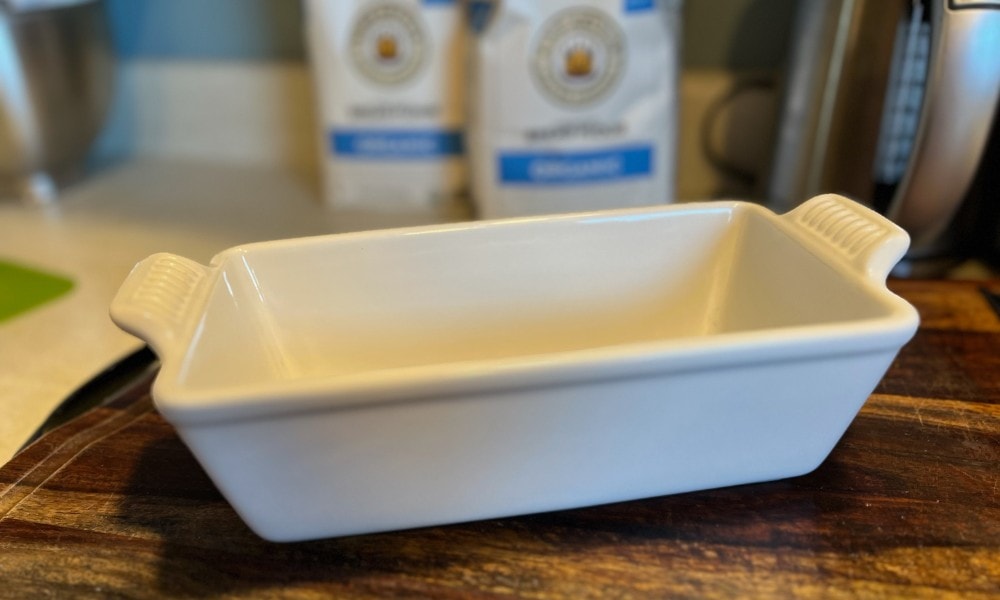
If you use artisan-made ceramic cookware, the glaze can leach lead into your food if it is improperly formulated or fired. If you frequently use ceramic cookware made with unsafe lead levels, the amount of lead will build up in your body over time and potentially cause a range of health problems. This is particularly dangerous for children, pregnant women, and unborn babies.
While researching, I found one case where a mother was admitted to hospital with severe abdominal pain. The cause was eventually found to be lead poisoning from a ceramic mug with a glaze that contained 17% lead. This mug was imported from Mexico, which, along with China, is known for exporting goods that contain lead.
Use Enamelware That’s Been Tested for Heavy Metals
In my eyes, the above study tells me two things: You need to test your glazed ceramics and enamelware for lead and avoid these products from China and Mexico specifically. This is why it is so important to buy your cookware from reputable brands with stringent testing to ensure that their cookware is safe.
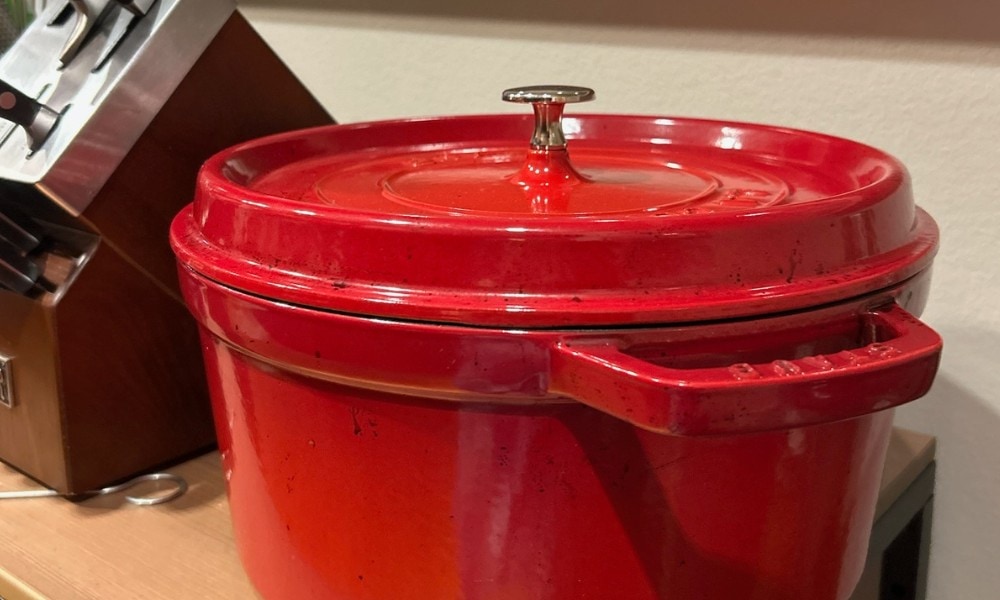
Many independent consumers like Lead Safe Mama conduct their own tests on a lot of cookware, especially Le Creuset. While these sources are not fully governmentally approved, they are useful for home cooks trying to find as much research on their cookware as possible.
While heavy metals is the primary concern, there are a few other questions that customers have regarding the safety of porcelain cast iron:
Does Enameled Cast Iron Leach Iron?
Enameled cast iron will not leach iron unless the coating is damaged. The enamel layer is completely nonreactive, so it is resistant to any ingredients, no matter how acidic.
Is Thermal Shock a Concern?
Some other cookware materials, like ceramic, are prone to thermal shock. This is when a quick change in temperature causes chips or cracks in the material. With enameled cast iron, this is rarely an issue. One of the main functions of the double layer of enamel is to resist thermal shock. The risk is also reduced by the slow-firing process that the glaze undergoes and the high alumina/silica ratio.
When I use my enamel cast iron, I’m only concerned about thermal shock when transferring a pot from the oven straight onto a cold granite countertop or another cold surface. You can easily avoid this risk by setting the pot on a pot holder.

Is Le Creuset non-toxic?
Since Le Creuset is such a high-end brand, it has strict safety guidelines to ensure its cookware is safe. While their cookware may not be 100% lead-free, their enameled cast iron has been approved by California’s Proposition 65 because it should not transfer the lead to your food.
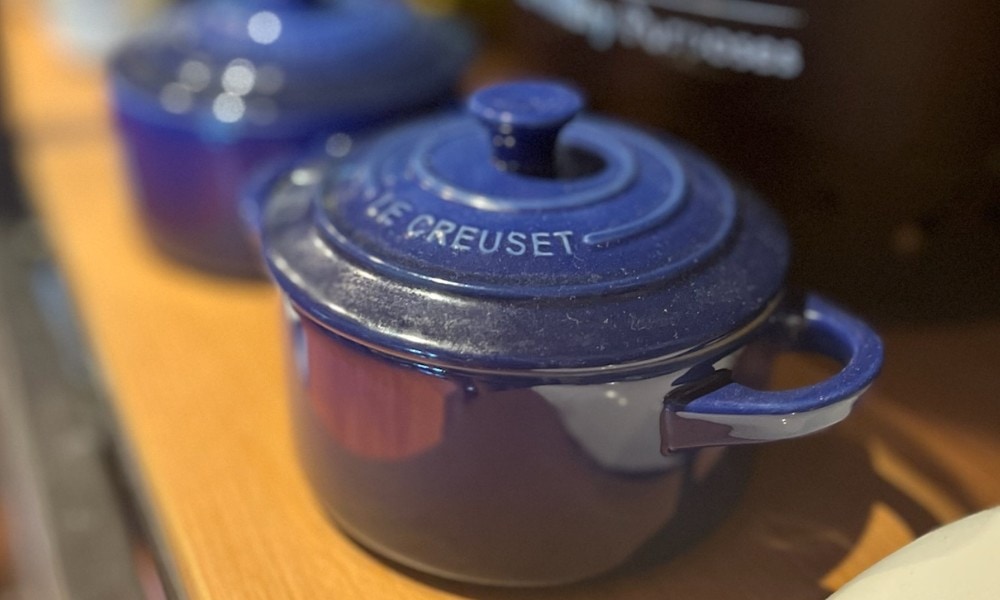
But if you buy an older Le Creuset pot, you should probably test it before using it. The first US regulations on lead in consumer goods were passed in the 1970s, and Prop 65 became law in 1986. Cookware made in past decades may be more likely to be contaminated with heavy metals.
Is Le Creuset Dangerous if the Enamel Scratches or Chips?
If the enamel on your Le Creuset or other porcelain-coated pan is damaged by sharp utensils or rough handling, it could flake into the food in the pan. Next thing you know, you could be chomping down on a chunk of enamel – ew! Besides being a nasty experience, this could potentially cause injuries to your teeth, mouth, or throat. If you have an older Le Creuset pot, there’s a risk it may contain lead or heavy metals, which is yet another reason why you wouldn’t want to ingest chipped enamel.
If the enamel chips, it will leave the raw cast iron exposed, which can lead to corrosion and rust. It will also destroy the nonreactive quality of your pan, so it will leach iron into your food, especially when cooking with acidic foods like tomato or vinegar.
How to Test for Lead in Your Cookware
Using Lead swabs is the easiest, but not very accurate method to test for lead in your cookware at home. Professionals and some very ambitious home testers use XRF (X-ray fluorescence) analyzer, which uses X-rays to determine the elemental makeup of a material.

Need proof? See our article on Testing Dutch Ovens For Lead At Home.
But if you want more accurate results that will tell you whether your cookware actually leaches lead into your food, you can send a sample of food cooked in your pot to a lab for testing.
How to Use and Maintain Enameled Cast Iron Cookware
As I’ve mentioned, I believe that buying enameled cast iron from reputable brands is your best shot at getting safe cookware. But even pots from well-known brands need to be maintained to prolong their lifespan and remain safe to use.
Here are a few essential tips for caring for your enameled cast iron properly:
This video by Made in Cookware gives some great tips for getting your enamel sparkling clean after each use. I’ve had stains on my enameled cast iron for years, and they shifted in just minutes using this vinegar and baking soda trick!
How Long Does Enamel Cast Iron Last?
Le Creuset cookware comes with a guarantee for the lifetime of the original owner. As they so charmingly put it on their website, the warranty lasts as long as you do.
The warranty covers manufacturing defects – but not “abuse” such as overheating or scratches from metal utensils.
If you care for it gently, though, you can probably pass your enameled Dutch oven to your grandchildren.
What Are the Best Brands of Enamel Cast Iron Cookware?
The top brands for enamelware are Le Creuset, Staub, and Lodge. These brands are expensive, but you are paying for peace of mind as well as high-performing cookware that will last a lifetime. These brands are all conveniently available on Amazon, but you can also buy them from their websites.
Le Creuset has the most extensive range with a beautiful color selection, making the brand world-renowned. Staub is equally as expensive and high-quality, but they have a more limited range in both products and colors. Lodge is the most affordable of all these brands, but their products are also tested according to FDA regulations 7.5.1.4a – Leachability of Lead and Cadmium for Glazed Ceramic Surfaces.
For a complete product roundup on high-end, safe enamelware, check out my article here.
What Are the Alternatives to Enamelware?
Due to the talk around lead exposure and enameled cast iron, many people feel safer avoiding it altogether. Regular cast iron is a good choice if you want the same searing quality and heat retention – but you will be limited as to what ingredients you can cook in it, and the maintenance is higher.
This Dutch oven from Emile Henry is a wonderful pure ceramic alternative that has wonderful heat retention – and a beautiful matte finish that looks just as luxe as colorful enameled cast iron.
When it comes to frying pans, I recommend this hard anodized aluminum frying pan from GreenPan. It has a very effective, healthy nonstick ceramic coating and a very durable surface that heats up quickly.
Pure ceramic, or stoneware, is a popular alternative to enamel cast iron because it has the same glass-like finish with a nonreactive surface. It also has wonderful heat retention that rivals cast iron. If you want a full breakdown of the pros and cons of stoneware and ceramic, then check out our article here.
Frequently Asked Questions about Enameled Cast Iron Cookware Safety
Is enameled cast iron safer than cast iron?
Yes, in many ways, enameled cast iron is safer than raw cast iron because it is less reactive. If you cook acidic foods like tomatoes or vinegar in raw cast iron, it will cause iron to leach into your food. This will discolor the dish and produce a metallic aftertaste. Enameled cast iron doesn’t have this problem so you can cook any ingredients in it safely.
What is enameled cast iron not good for?
The great thing about enamelware is how versatile it is. You can do anything with it, from searing, sauteing, slow cooking, boiling, frying, and even baking bread. You can buy skillets, Dutch ovens, casserole dishes, saute pans, and so many other pieces that I’d challenge you to find a dish you can’t make in enameled cast iron!
How can you tell if cast iron has lead in it?
As I have mentioned, any new enamelware must be labeled if it exceeds the lead and cadmium levels stipulated by Proposition 65. You can also call or email manufacturers and ask if they have results from third-party testing. But if you already own enameled cast iron or you thrift it vintage, then I suggest buying a lead testing kit so you can know for sure that it is safe.
Conclusion
So now that we’ve thoroughly investigated porcelain enamel cookware, what’s the takeaway? Ultimately, in the US, legally, enameled cast iron that exceeds the acceptable levels of lead needs to be labeled so you can avoid it. The best way to keep yourself safe is to only buy from reputable brands and avoid those knock-offs that are made in countries that don’t have rigorous testing or quality control.
Don’t be shy to do your own research every time you invest in new cookware! The peace of mind knowing that it’s safe for you and your family is worth the time.

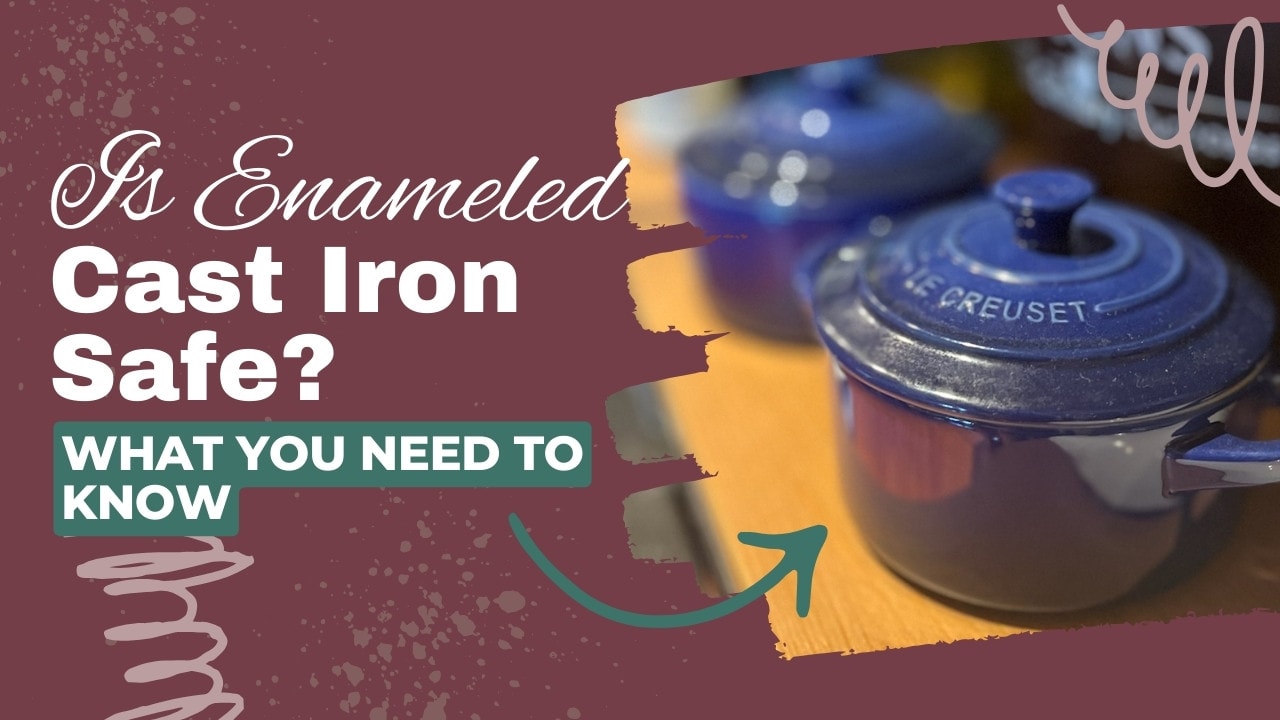


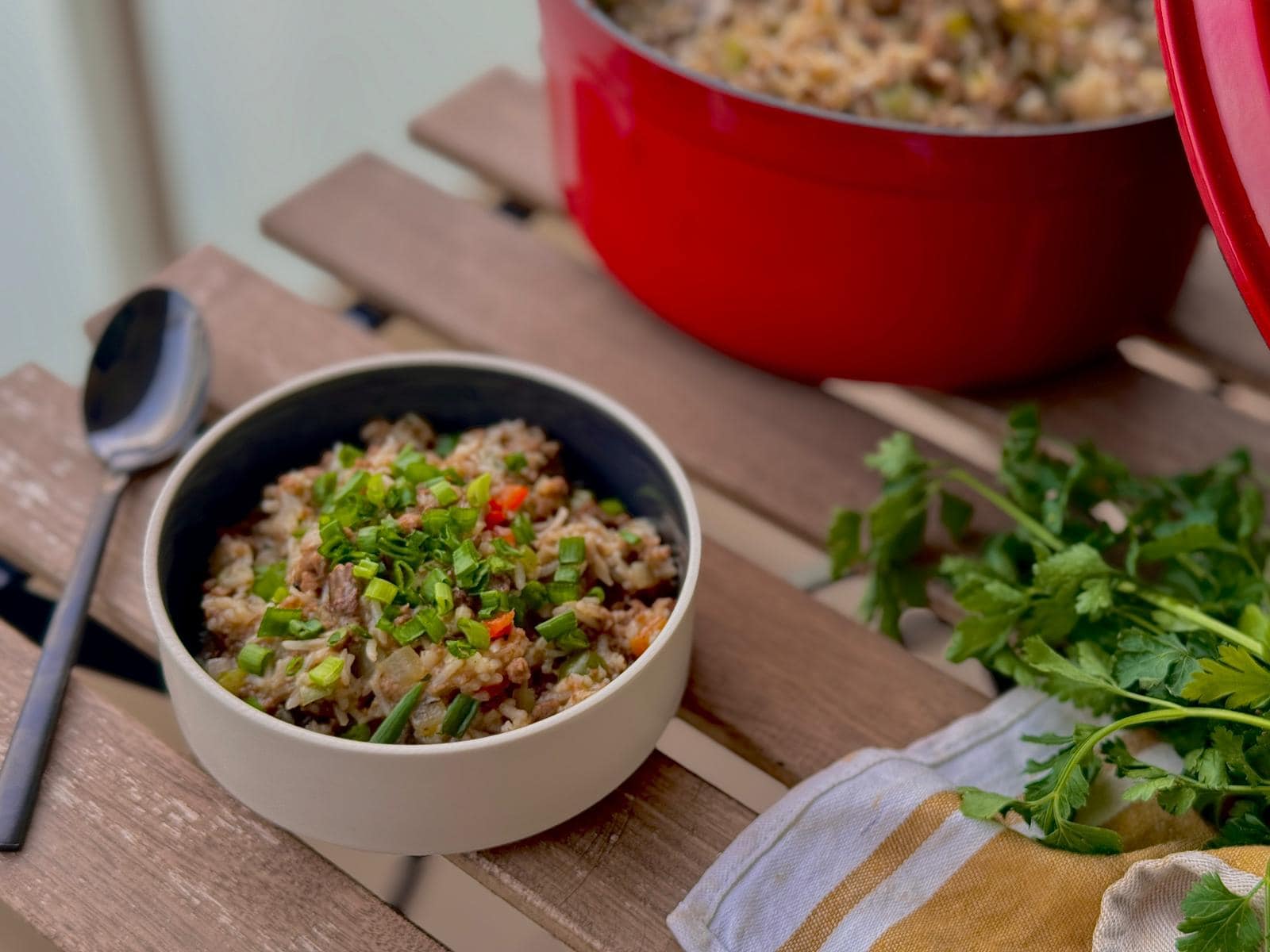







Thank you for your information. I recently found a vintage Copco small Dutch oven, green in color, with porcelain coating in pretty good condition. There is a small chip by the top rim. I can’t find enough information to feel good about using it. I would be very grateful for any input from you. Thank you so much.
Hi there, thank you for your question. Firstly, if the chip is only on the rim I wouldn’t worry too much as it won’t make contact with your food. Just watch out for rust and dry it well when you wash it. The main worry is that vintage enameled cast iron pieces are more likely to contain traces of lead. I recommend buying a lead testing kit like this one to test the interior and exterior enamel before you cook in it.